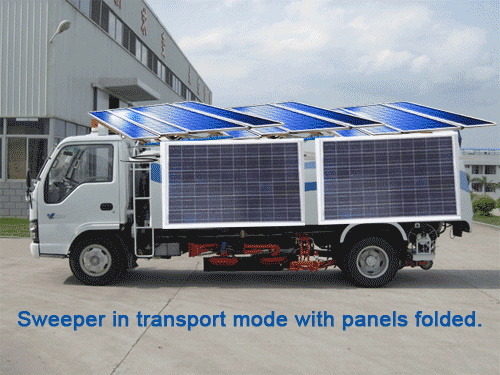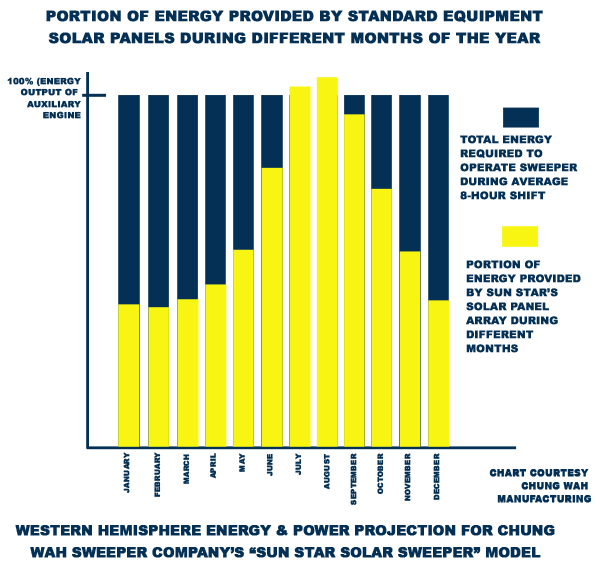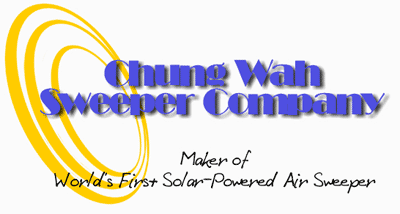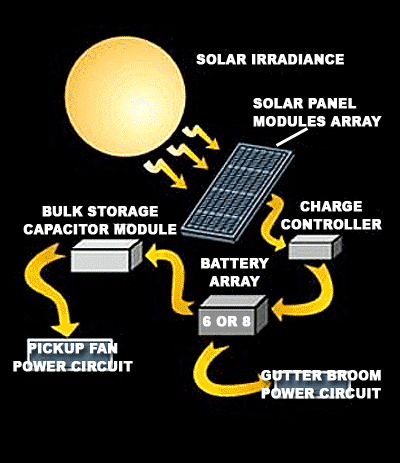Chinese Manufacturer Announces
|
|
FOR IMMEDIATE DISTRIBUTION April 1, 2011Shanghai, China –
First Solar-Powered Sweeper Announced by Chinese Firm, Chung Wah Sweeper Company

In a move that could solidify the company's place in the worldwide sweeping industry, the president of the Chung Wah Sweeper Company, Xiao Peng, today announced the world's first air sweeper to have its auxiliary engine offset by solar power. The Sun Star Solar Sweeper is outfitted with a total of seven high-efficiency solar panels; two on each of the sides of the hopper and three on the top. Automatic rotation toward maximum solar gain is accomplished by a small DC motor attached to the base of each of the roof-mounted solar panels. In a sort of high-tech international trade-off, the rotation system will use US-based Westinghouse Electric's patented 'Solar-Seek'TM servo technology in order to constantly maximize solar gain while sweeping. "For several months of the year," says Peng, "our air sweeper will run all the time on just the electric power produced by the high-efficiency solar panels mounted on the side and on the top of it. In other months, there will be significant diesel cost offset from the panels."
"Once about 65% of capacity has collected within the batteries," says Peng, "they are able to operate the curbs broom (sic) 100% and also send current to the Bulk Storage Capacitor Module (BSCM). When the BSCM has gained a charge of between 90-93%, it is able to switch the sweeper's large pickup fan over to solar-only operation. The diesel auxiliary engine has an auto-circuit to start and stop it automatically, as necessary." Chung Wah's Sun Star Solar Sweeper is designed strictly for daytime street sweeping, since to obtain reasonable payback the machine must be operated during daylight hours. No plans are currently in the works for a parking area class of sweeper, since those are typically operated during nighttime hours. The initial sweeper designed for U.S. and European import will have a 4.6-cubic meter (6-cubic yard) hopper, and will be mounted on a chassis still to be announced. Even though it will be mounted onto a standard production chassis, the Sun Star will only have a transport top speed of 80 kilometers per hour (about 50 mph) even with the solar panels in 'tuck position.' That's to ensure there is no possibility of 'shearing' the panels from their 3-point steel-and-alloy bracket mounts. Another disadvantage to the Sun Star is it will not be able to operate where height is a factor, since even folded down the solar array adds .8/meter (2'-7.5") to the standard hopper height of 2.87/meters (113"). When the solar panels are deployed and in 'auto-angle mode' so as to maximize power input during sweeping, overall clearance for safe operation must be at least 4.5/meters (14'-9"). This is too tall for safe operation under the overhanging branches and other low-hanging obstructions encountered in most municipal sweeping situations. "The Sun Star will be best for freeway and highway sweeping, not for sweeping in the towns," says Peng. "Where the Sun Star sweeps there must not be low tree branches or other objects that might harm the solar panels. Even scratching them would be bad for the service life they can provide, and severe scratches can also void the warranty. The decrease in cost of operation makes our Sun Star perfect for highways, though." 
As may be seen by the chart, above, during the hottest of the summer months in the Western Hemisphere the Sun Star's solar power system is projected to provide more power than what is actually needed. Then, during the two off-peak months on either side, the sweeper is expected to operate 50%+ via solar power. Even in the coldest months of December – March, the Sun Star Solar Sweeper is projected to run, on an average, over 30% of the time via its onboard BSCM-regulated solar system. "With the cost of diesel fuels rising," says Peng, "we felt the time was right to bring our amazing innovation to the large sweeper market in the U.S. and Europe. Even though the added cost of our panels will not be covered during the life of just one sweeper, the panels and charging system may be inexpensively moved from sweeper-to-sweeper since the panels themselves have an expected lifespan of over 40 years. Our warranty on the solar panel system will be 25 years, or five times more years than the warranty on the sweeper itself." For more information, including expected cost, a spec sheet, more photos and a complete analysis chart breaking down the Sun Star's expected solar-to-diesel operating ratio, use this link to check out Chung Wah Sweeper Company's English language website. If you have input or comments on this story, or have information on other innovative sweeper-related technology, you may reach WorldSweeper.com by sending email to editor@worldsweeper.com.
Editor's Note: In 2014, WorldSweeper's Italian Correspondent, Victor Abbuendanza, wrote an article about the various sweeper types he had seen in Europe and Asia that were largely unknown in the U.S. One of those was a newly developed solar-powered street sweeper in use in China. Check out the coverage, which appeared on the World Sweeping Association's website.
|


 As shown in the diagram to the right, the solar power produced by the panels is collected via the Charge Controller, then sent to the Battery Array – a 6-battery array is standard, and an 8-battery system is optional. Because less power is required to operate the gutter (curb) broom, it will function via solar with much less sunlight than what is required to turn the pickup fan.
As shown in the diagram to the right, the solar power produced by the panels is collected via the Charge Controller, then sent to the Battery Array – a 6-battery array is standard, and an 8-battery system is optional. Because less power is required to operate the gutter (curb) broom, it will function via solar with much less sunlight than what is required to turn the pickup fan.